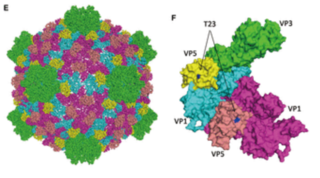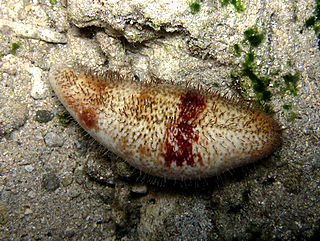Related Research Articles

Sea cucumbers are echinoderms from the class Holothuroidea. They are marine animals with a leathery skin and an elongated body containing a single, branched gonad. Sea cucumbers are found on the sea floor worldwide. The number of holothurian species worldwide is about 1,717 with the greatest number being in the Asia Pacific region. Many of these are gathered for human consumption and some species are cultivated in aquaculture systems. The harvested product is variously referred to as trepang, namako, bêche-de-mer or balate. Sea cucumbers serve a useful role in the marine ecosystem as they help recycle nutrients, breaking down detritus and other organic matter after which bacteria can continue the degradation process.
Luteoviridae is a family of viruses. Plants serve as natural hosts. There are currently 51 species in this family, divided among three genera, with seven unassigned species. Diseases associated with this family include: yellowing symptoms.

The Malpighian tubule system is a type of excretory and osmoregulatory system found in some insects, myriapods, arachnids and tardigrades.

The Old World silversides are a family, Atherinidae, of fish in the order Atheriniformes. They occur worldwide in tropical and temperate waters. About two-thirds of the species are marine, and the remainder live in fresh water. The 74 species are in 13 genera. The genus Craterocephalus is the most diverse with 25 species. Four genera are monotypic.

Cypovirus, short for cytoplasmic polyhedrosis virus, is a genus of double-stranded RNA viruses in the family Reoviridae and subfamily Spinareovirinae. Cypoviruses have only been isolated from insects. Diseases associated with this genus include: larvae chronic disease. There are currently 16 species in this genus including the type species Cypovirus 1.
Evisceration is a method of autotomy involving the ejection of internal organs used by animals as a defensive strategy. Sea cucumbers (Holothuroidea) eject parts of the gut in order to scare and defend against potential predators such as crabs and fish. The organs are regenerated in a few days by cells in the interior of the sea cucumber.
Karyolysus is a genus of coccidia. With the exception of K. sonomae whose vertebrate host is the yellow-legged frog, species in this genus only infect lizards of the genus Lacerta.
Legerella is a genus of parasitic alveolates of the phylum Apicomplexa. Species in this genus that usually infect the malpighian tubules of invertebrates.
Hyaloklossia is a genus of parasitic alveolates in the phylum Apicomplexa. Only one species in this genus is currently recognised - Hyaloklossia lieberkuehni.
The Neogregarinorida are an order of parasitic alveolates in the phylum Apicomplexa. Species in this order infect insects and are usually found in the fat body, hemolymph, hypodermis, intestine or Malpighian tubules. The most common site of infection is the fat body: many species are pathogenic for their hosts.
The Caulleryellidae are a family of parasites in the phylum Apicomplexa. Species in this family mostly infect dipteran larvae.
The Gigaductidae are a family of parasites in the phylum Apicomplexa. Species in this family infect Coleoptera (beetles) and Orthoptera (grasshoppers).
Mattesia is a genus of parasitic alveolates of the phylum Apicomplexa. Species in this genus infect insects.
The Diplocystidae are a family of parasitic alveolates in the phylum Apicomplexa.
The Ganymedidae are a family of parasites in the phylum Apicomplexa.
Machadoella is a genus of parasitic alveolates in the phylum Apicomplexa.
Menzbieria is a genus of parasitic alveolates of the phylum Apicomplexa.
Lipocystis is a genus of parasitic alveolates of the phylum Apicomplexa.
Nephridiophaga is a genus of single cell eukaryotes that pathogenically inhabit the Malpighian tubules of insects. Ivanic described the type species from honey bees.

Actinopyga capillata, the hairy sea cucumber, is a species of sea cucumber in the family Holothuriidae. It is found in the tropical West Indo-Pacific region, having a disjunct range, with the main population in island groups in the western Indian Ocean, and a separate population in the Philippines.
References
| | This Apicomplexa-related article is a stub. You can help Wikipedia by expanding it. |